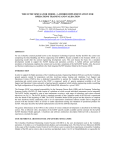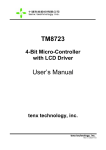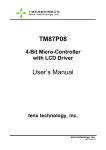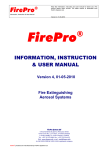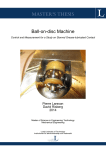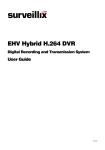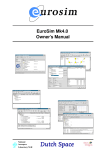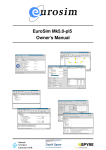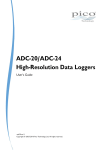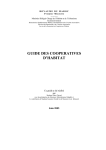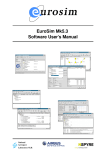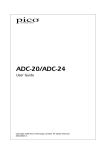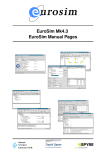Download View/Open - of NLR Reports - National Aerospace Laboratory
Transcript
UNCLASSIFIED Nationaal Lucht- en Ruimtevaartlaboratorium National Aerospace Laboratory NLR Executive summary The EuTEF Simulator Model: a hybrid implementation for operations training and validation Report no. NLR-TP-2008-488 Author(s) E.A. Kuijpers K.A. van Aarsen E. Dutruel A.J. Kramer Z. Pronk F. Raijmakers Report classification UNCLASSIFIED Date September 2008 Knowledge area(s) Space Problem area The EuTEF Simulator Model(ESM) is a tool for training and validation of EuTEF operations. In order to support the operations of the Columbus payloads, some Engineering Models (EM) are used by the ground segment, mainly for preparatory activities involving testing, training and validation. For one external payload, the European Technology Exposure Facility (EuTEF) only the central core, the Data Handling and Power engineering Unit(DHPU), was available as part of the normal development cycle. A few instrument hardware models were expected to become available. The EuTEF Simulator Model (ESM) project had the objective to complete the basic facility architecture with a set of representative instrument software models and to integrate with the ERASMUS User Support Operation Centre (USOC) infrastructure to enable operational training and validation of operational products for EuTEF. Descriptor(s) Simulation EuTEF Telescience USOC Description of work The architecture contains a generic part including a model for data This report is based on a presentation at the 10th International Workshop on Simulation for European Space Programmes, Noordwijk, 7-9 October 2008. UNCLASSIFIED UNCLASSIFIED The EuTEF Simulator Model: a hybrid implementation for operations training and validation interfacing with the EuTEF DHPU and an instrument specific part implemented via a higher level rulebased coding formalism. The ESM implements all the interfaces of the EuTEF DHPU EM. Five instruments hardware models with various degrees of fidelity became available during the development. he realism of the ESM implementation allowed integrating the hardware models while keeping the advantages of software simulation. The software simulation of instruments replaces missing hardware instruments and provides the flexibility and functionalities not available with the instrument hardware models. Both the RS-422 and Mil-Std-1553 type instrument interfaces have been implemented within a EuroSim simulation environment. Stimuli to represent the power usage of instruments and thermistors for EuTEF monitoring have been implemented. For one instrument, the Earth Viewing Camera (EVC), the high rate bit stream interface which is handled by Columbus has been implemented as a hardware adapter to connect to the ERASMUS USOC infrastructure. Results and conclusions The design and experiences using the EuTEF Simulator Model are described. The hybrid design concept selected initially turned out to be a more challenging effort than anticipated, but reuse of the central EuTEF DHPU EM proved to be essential. For continued operational use the separation between the instrument model specifications and the ESM core software will allow to integrate flight experiences. Applicability The design will be used for training and validation of EuTEF operational products. ESM was developed under ESA contract no. 13980/99/NL/PG: WO-14 realised with Dutch national support for the Erasmus USOC. Nationaal Lucht- en Ruimtevaartlaboratorium, National Aerospace Laboratory NLR UNCLASSIFIED Anthony Fokkerweg 2, 1059 CM Amsterdam, P.O. Box 90502, 1006 BM Amsterdam, The Netherlands Telephone +31 20 511 31 13, Fax +31 20 511 32 10, Web site: www.nlr.nl Nationaal Lucht- en Ruimtevaartlaboratorium National Aerospace Laboratory NLR NLR-TP-2008-488 The EuTEF Simulator Model: a hybrid implementation for operations training and validation E.A. Kuijpers, K.A. van Aarsen1, E. Dutruel2, A.J. Kramer, Z. Pronk and F. Raijmakers1 1 Atos Origin 2 ESA/ESTEC -TEC-SWG This report is based on a presentation at the 10th International Workshop on Simulation for European Space Programmes, Noordwijk, 7-9 October 2008. The contents of this report may be cited on condition that full credit is given to NLR and the authors. This publication has been refereed by the Advisory Committee AEROSPACE SYSTEMS & APPLICATIONS. Customer European Space Agency Contract number 13980/99/NL/PG: WO-14 Owner National Aerospace Laboratory NLR + partner(s) Division NLR Aerospace Systems & Applications Distribution Unlimited Classification of title Unclassified April 2009 Approved by: Author Reviewer Managing department Nationaal Lucht- en Ruimtevaartlaboratorium National Aerospace Laboratory NLR NLR-TP-2008-488 Summary For one Columbus external payload known as the European Technology Exposure Facility (EuTEF) the central core comprising the Data Handling and Power engineering Unit (DHPU), became available to the Erasmus USOC as an engineering model after the normal engineering development cycle. This unit became the basis for a simulator development needed to support the EuTEF training and operations activities. A hybrid software and hardware simulation of instruments completes the central core to provide a simulation of the full EuTEF facility. Also, the power and thermal conditioning was modelled in the final integrated EuTEF Simulator Model at the Erasmus USOC. ESM was developed under ESA contract no. 13980/99/NL/PG: WO-14 realised with Dutch national support for the Erasmus USOC. 3 NLR-TP-2008-488 Contents ABSTRACT 7 INTRODUCTION 7 USOC REFERENCE ARCHITECTURE AND GENERIC SIMULATORS 8 HYBRID CONCEPT PAYLOAD SIMULATION 9 HARDWARE OVERVIEW 10 SOFTWARE DESIGN 11 Scheduling Of Mil-1553 Instrument Models 12 RS-422 Instrument modelling 13 Modularity for Instrument Modelling 13 14 EXPERIENCES EuTEF DPHU EM 14 RS-422 Instrument Implementation Experiences 15 Mil-Std-1553 Instruments Implementation Experiences 15 Use of EVC Bitstream 15 15 CONCLUSIONS AND LESSONS LEARNED 16 Acknowledgements 16 REFERENCES Appendix A 17 Presentation handout 4 NLR-TP-2008-488 Abbreviations BDE Batch Data Entry CCSDS Consultative Committee on Space Data Systems CD-MCS Columbus Distributed Monitoring and Control System Col-CC Columbus Control Centre DHPU Data handling and Power Unit EDR European Drawer rack EM Engineering Model EPSS EDR-PCDF System Simulator ESA European Space Agency ESM EuTEF Simulator Model EuTEF European technology Exposure Facility EVC Earth Viewing Camera FIPEX Flux-Probe Experiment FRC Facility responsible centre HRDL High Rate Data Link HRDP High Rate Data Processor MDB Mission Data Base MEDET Materials Exposure and Degradation Experiment PaCTS Payload Computer Test System PCDF Protein Crystallisation Diagnostic Facility PI Principal Investigator PLEGPAY Plasma Electronic Gun Payload STD State Transition Diagram TAXI Transparent Asynchronous Transmit/Receive Interface USOC User Support Operations Centre YAMCS Yet Another Monitoring and Control System 5 NLR-TP-2008-488 THE EUTEF SIMULATOR MODEL: A HYBRID IMPLEMENTATION FOR OPERATIONS TRAINING AND VALIDATION E.A. Kuijpers (1), K.A. van Aarsen(2), E.Dutruel(3), A.Kramer(1), Z.Pronk(1), F.Raijmakers(2) (1) National Aerospace Laboratory NLR, Space department P.O.Box 153, 8300 AD Emmeloord, the Netherlands E-mail: [email protected], [email protected], [email protected] (2) Atos Origin Papendorpseweg 93, 3528 BJ Utrecht E-mail: [email protected], [email protected] (3) ESA/ESTEC -TEC-SWG P.O.Box 2999, 2200AG Noordwijk , the Netherlands E-mail: [email protected] ABSTRACT For one Columbus external payload known as the European Technology Exposure Facility (EuTEF) the central core comprising the Data Handling and Power engineering Unit (DHPU), became available to the Erasmus USOC as an engineering model after the normal engineering development cycle. This unit became the basis for a simulator development needed to support the EuTEF training and operations activities. A hybrid software and hardware simulation of instruments completes the central core to provide a simulation of the full EuTEF facility. Also, the power and thermal conditioning was modelled in the final integrated EuTEF Simulator Model at the Erasmus USOC. INTRODUCTION In order to support the flight operations of the Columbus payloads, Engineering Models (EM) are used by the Columbus ground segment, mainly for preparatory activities involving testing, training and validation. User Support and Operations Centres (USOCs) have a dedicated responsibility to operate the Columbus payload facilities. The data monitoring and control system used at the USOC is composed partly of generic equipment available to all User Support and Operation Centres and partly of payload specific equipment which includes engineering models resembling the flight configuration of the payloads, the Flight Model(FM), allocated to a given USOC. The Erasmus USOC was assigned responsibility for the European Drawer Rack (EDR) and the European Technology Exposure Facility (EuTEF) [1]. Both consist of a platform on which several individual instruments can be integrated. The EuTEF facility integrates a suite of nine instruments covering a wide range of technology and science research objectives (see Fig. 1). The EuTEF facility is attached externally to the Columbus model of the ISS and is operational since the launch at the beginning of 2008. The EuTEF Simulator Model (ESM) project had the objective to complete the basic hardware facility architecture with a set of representative instrument software models and to integrate all systems with the Erasmus USOC at ESTEC to enable operational training and validation of operational products for EuTEF. This paper describes the hybrid implementation used for the ESM development. 6 NLR-TP-2008-488 The generic infrastructure at the USOCs in the context of various simulator developments is described in the following section. This is followed with a description of the EuTEF specific models available and the rationale for the hybrid EuTEF Simulator Model approach. A hardware and software architecture description followed with a discussion of experiences concludes the paper. USOC REFERENCE ARCHITECTURE AND GENERIC SIMULATORS The Columbus Distributed Monitoring Control System (CD-MCS) is the core development used in the Columbus operations. It includes a set of standardized data displays and commanding tools. The Data Services Subsystem (DaSS) in the scope of the Columbus Control Centre (Col-CC) allows users to control their experiments on board the Columbus Module of the ISS and to retrieve data in real-time and playback mode. Col-CC in Oberpfaffenhofen is responsible for the ground segment coordination of the multiple USOC inputs. Simulators exist for use with the USOCs, Col-CC and the European Astronaut Centre (EAC). The fidelity for the payload modelling is limited and general purpose simulation and reuse of Columbus development facilities has been emphasised in the design [2] not allowing USOC reuse. Fig. 1. EuTEF instruments (FM on the left, courtesy NASA) are controlled by the EuTEF DHPU. The EVC camera is oriented towards the earth, while many other instruments measure the space environment. At the USOC premises Engineering Models are used in combination with a set of generic simulators dedicated to the USOC tasks. The following general purpose tools are available which can be used in combination with all Columbus payloads (see left Fig. 2): • The Columbus Emulator is a hardware setup consisting of 4 PCs integrated in a rack which represent the Columbus infrastructure for payload facilities. It includes a representative hardware interface to the payloads including the Mil-Std-1553 bus and Ethernet. Columbus Payload Facility Engineering Models can be connected directly to the Columbus Emulator. • The SESS simulator is a Java based software tool which can be used as a CCSDS packet router and contains basic facilities for payload and Columbus simulation for test purposes. • The MARS simulator is a PC tool to simulate TC/TM flow for payloads and CCSDS interfaces encapsulated in DaSS, UDP or TCP/IP. This simulator can import a facility payload database in the PaCTS format used during the payload development and is part of the PaCTS related toolset used for test and development. 7 NLR-TP-2008-488 Fig. 2. Integration of the EuTEF Simulator Model in the USOC infrastructure. The above elements were used for integration with EDR software simulation and EM integration. EDR is a rack facility internal to Columbus where two types of drawers can be integrated. The Protein Crystallisation Diagnostic Facility (PCDF) is the first payload for EDR. A full EDR PCDF System Simulator (EPSS) was used to support the development and training at the USOC while the EDR EM was in use for other activities or the PCDF-EM was not available. Once the EDR-EM became available the simulator proved to be still useful in the context of fault-injection simulation and for training. As shown in Fig. 2 a similar approach was used to integrate the hybrid approach taken for ESM. HYBRID CONCEPT PAYLOAD SIMULATION The approach taken with the EuTEF simulation was different compared to the EDR software simulation as a full EuTEF engineering model was definitively not available. The approach is to be contrasted with a full software simulation and a full instrument payload development model with representative hardware. At the Erasmus USOC this was done for one demo drawer [3], but for EuTEF a hardware based effort was felt to be too expensive for nine instruments. Software simulation was feasible for EDR/PCDF in the EPSS project. A simulation of a LIDAR instrument on ISS was exercised previously [4]. To ensure sufficient realism a compromise between hardware and software was selected. The main design drivers for the ESM were: 1. Reuse the EM of the EuTEF DHPU (Data Handling and Power Unit) as a central core for the simulator to guarantee the required hardware compatibility with the RS-422 and Mil-Std-1553 standards for the data handling interfaces. 2. Use of an Earth Viewing Camera Development hardware model which was assumed to become available later during the development. 3. Use of an instrument MDB(i-MDB) TM/TC database to ensure consistency for the instrument interfaces with other Erasmus USOC developments and to reuse potential improvements as the information about the specific instruments was limited at the start of the project. 8 NLR-TP-2008-488 Fig. 3 depicts the central place of the EuTEF DHPU EM in the hybrid architecture concept and its conditioning and monitoring. The architecture contains a generic part including a model for data interfacing with the EuTEF DHPU and an instrument specific part implemented via a high level rule-based coding formalism. The ESM implements all the interfaces of the EuTEF DHPU EM. Both the RS-422 and Mil-Std1553 type instrument interfaces have been implemented within a EuroSim simulation environment. Stimuli to represent the power usage of instruments and thermistors for EuTEF monitoring have been implemented. The Earth Viewing Camera (EVC) Development Model (DM) is a realistic model for the data handling for the EVC Flight Model as integrated in EuTEF for which realistic hardware interfaces would be needed. Fig. 3. The EuTEF DHPU EM is conditioned and monitored with representative data interfaces. HARDWARE OVERVIEW In the following the main hardware components are described where all interfaces had to comply with the EuTEF DHPU EM connectors (J1 up to J16, see Fig. 4): • Mil-Std-1553 board connecting to J12 allowing for Mil-bus instruments to be simulated with the addresses 1 up to 5 which could be disabled in case an instrument hardware model was available. • RS-422 interface board connecting to J11 for the four RS-422 instruments in EuTEF which could be simulated and disabled when the instrument hardware model was available. • A digital I/O module for power-on detection (J2 and J3) allowed to synchronise the EuTEF DHPU power outlets with the instrument software simulation start-up. • A digital I/O module for digital line (J16) detection controlling relays via the EuTEF DHPU • Interface to resistors simulating temperatures (J15). 9 NLR-TP-2008-488 Fig. 4. ESM hardware interfaces with EuTEF DHPU EM. The PC hardware platform was selected to run the Linux operating systems and support 3 PCI slots based on a Dell Precision 390 Mini-tower with an Intel® CoreTM 2 Duo® Processor Dual Core Technology. Compatibility was foreseen with the Columbus bitstream interface to integrate the EVC DM. This interface is based on an electrical TAXI interface for the external payloads. At the Erasmus USOC only an optical interface was available as used for the internal Columbus payloads. As part of the EuTEF Simulator Model project an electrical to optical TAXI converter was developed built for interfacing to the EVC DM. SOFTWARE DESIGN The software contains three main components (see Fig. 5): • The generic EuroSim based platform (green/yellow line pattern) • The generic EuTEF instrument interface software (yellow) • Specific EUTEF instrument modeling software (blue) The software design had to be compliant with the EuTEF interface and operational documentation available to the project [5-7]. The specific EuTEF instrument modeling (Blue in Fig. 5) is mainly based on dedicated scripts in which the user can customize the modeling in State Transition Diagram (the corresponding scripts are called STD-files). A rule-based formalism was used where the user could specify definitions, conditions and event and actions. The following describes part of the syntax: definitions = 'DEFINITIONS:’, '\n’, c_definitions, '\n’ 'ENDDEFINITIONS’, '\n’ ; c_definitions = <any C code in global scope> ; event = 'EVENT:’, event_trigger, '\n’, 10 NLR-TP-2008-488 [ 'CONDITIONS:’, conditions, '\n’, ] [ 'RESPONSE:’, response_statement, '\n’, ] [ 'COMMENT:’, quoted_string, '\n’, ] 'ACTIONS:’, '\n’, c_statements, 'ENDACTIONS’, '\n’ ; The generic EuTEF instrument interface software is build on top of the general purpose EuroSim simulation environment. The i-MDB is the main database describing the CCSDS data packets definitions for TM/TC interface to the EuTEF Instruments. The CCSDS packets could be mapped directly on the RS-422 and MilStd-1553 internal bus formats. For communication between the ESM and the CD-MCS, the ESM SW module needs to be able to decode TC packets and encode TM packets in compliance to the packet definitions described the i-MDB. Because the data packets definitions are large in number and size and because they may be subject to version updates, decision was taken to develop a tool to automatically generate encoding and decoding functions from the i-MDB for usage in the simulator. This tool written in Perl, parses the so-called BDE files which are a direct extraction of the i-MDB in order to generate structure definitions, encoding functions and decoding functions in C language. When the i-MDB is updated the encoding and decoding functions can be quickly regenerated after which only a simulator model recompilation is needed. Fig. 5. Overview of the EuTEF Simulator Model Software. Scheduling Of Mil-1553 Instrument Models For the instruments using the Mil-1553 bus interface (TRIBOLAB, EUTEMP, MEDET, PLEGPAY) the scheduling of the simulator models follows the communication scheduling on the Mil-1553 bus itself. This scheduling is forced by the DHPU as the Bus Controller (see Fig. 6). Basically, the Mil-1553 bus scheduling follows a cyclic schedule consisting of one so-called major frame with a duration/period of 10 seconds. A major frame consists of 100 so-called Processing frames with a duration of 100 milliseconds. The Processing Frame is subdivided in (16*8=) 128 slots (called Basic Frames). Each slot relates to a Mil message transmission, that is all communication needed to send the contents of one sub address of the BC (Bus Controller) or a particular RT (Remote Terminal). The processing Frame has the following characteristics: • During the first half only BC -> RT communication is taking place consisting of: o A broadcast synchronization packet with processing frame number (always) 11 NLR-TP-2008-488 • o A broadcast time packet (every 10th processing frame) o One Telecommand to any instrument (optional) During the second half only RT -> BC communication is taking place consisting of following TM data all from one and the same instrument: o Health data, House Keeping data, Science data o Instrument Command Response on the Telecommand for first half of the Processing Frame. o IM specif. TC IM TC MMI TC route Operator IM TC TC Data RT # TC in Mil packet Mil Rx buffer DHPU EuroSim Scheduler events STD modeling General TC Read / decode TC Data (encoded) RT # SA # Get TC IM TM + Command Response Generic TC handling Synchronize Send TM IM TM MMI Mil routing TM in Mil packet Mil Tx buffer TM Data (encoded) Model ID type TM Data (encoded) RT # SA # TM encode Fault IM send TM TM Data Model ID type . Fault Injection MMI Fig. 6. Scheduling of Mil-bus instruments and data flow in ESM. The data rate for the Housekeeping packets is 0.1 Hz, 1 Hz for the Science packets and a health status rate of 1 Hz. The EuTEF DHPU EM controls the rates and the simulator has to comply. RS-422 Instrument Modelling For the RS-422 instruments the interface specifications of the EuTEF DHPU EM and instruments were used to implement a generic model in which specific deviations for the individual instruments were added. For the RS-422 instruments the refresh rate when selecting continuous mode can range from 0.1 Hz to 1 packet/hour. Therefore, the user has to request explicitly for one shot science or housekeeping telemetry for the RS-422 instruments (one_shot_HK and one_shot_SC). The health information becomes available at a low frequency (0.1Hz). Modularity for Instrument Modelling The level of detail is limited to the scope of the ESM requirements and can be easily expanded via de STDfiles representing each instrument. Due to limited information about the as-built instrument behaviour, it was felt a rule like formalism could be the basis for improvements later. In a first iteration a subset of commands which could be executed with the flight model on ground was the basis. Based on those experiences an attempt was made to enhance realism via dedicated coding in the action part of the STD-rules. For each instrument a dedicated timer variable is available in the STD-files which was incremented every second. The user can use this to mimic events with some delays and transient behaviour. Note that the response for each instrument depends on the interfacing method commanded via the EuTEF DHPU EM for housekeeping 12 NLR-TP-2008-488 (HK) or science (SC) telemetry. For both the Mil-Std-1553 standard and RS-422 the user had to enable the continuous acquisition via control of the EuTEF DHPU just as with the Flight Model. An effort has been made to represent typical command responses in the simulator. EXPERIENCES Five instruments hardware models with various degrees of fidelity became available later during the ESM development. The initial hybrid design concept selected for the ESM allowed us integrating the newly available hardware models while keeping the advantages of a flexible software simulation environment. The software simulation of instruments replaces missing hardware instruments and provides the flexibility and functionalities not available with the instrument hardware models. To have a telemetry en telecommanding resource with ESM did not only prove relevant for training, but also for the debugging of the ground infrastructure which was quite complicated [8]. In retrospect a lot of simulators were used before and during the project, but somehow they all had their purpose. The integration and data routing was straightforward for the telemetry and telecommanding being routed via the EuTEF DHPU. The original objective to have plugand-play using the i-MDB import could be demonstrated. During the development several i-MDB updates could be imported without any difficulties. The hardware is shown in Fig. 7 with the power load and thermal load simulation on the left-middle and the control on the right. The TAXI-convertor is integrated on the leftbottom corner. In the background the Columbus Emulator and EuTEF DHPU related equipment(upper half) is shown. Fig. 7. Hardware overview of ESM components. EuTEF DPHU EM The central core of the facility was used for testing a major software patch to be uploaded onto the FM facility. Following the update a reformatting of the on-board mass memory proved to be needed. This type of debugging could only be performed with the EM. In view of unavailability of the EuTEF DHPU EM for repairs and the need for a software development environment, a simplified EuTEF DHPU routing software simulation was added. For detailed power load simulation facilities are available but have to be fine-tuned pending detailed requirements for operational analysis and training. The instruments in EuTEF can be scheduled using a set of files called the EuTEF Operations Plan (EOP). However, for schedules lasting up to a week validation was difficult. As the ESM is a mix of software and hardware just speeding up a simulation is not possible. Three approaches were considered: A. a time stepping method; B. a preprocessing of the schedule; C. A dedicated checking implementation. Option A 13 NLR-TP-2008-488 could not be implemented in view of limitations of the EuTEF DHPU EM/Columbus Emulator time interface. Option B required pre-processing of an operational product which is not attractive. For option C a dedicated tool was developed by Space Applications Services, Belgium, as partner in the Erasmus USOC which proved to be sufficient, but for debugging the ESM set-up was needed. RS-422 Instrument Implementation Experiences Using the STD formalism the RS-422 instruments were modelled with realism depending on the instrument hardware models which became available during the project. A DEBIE2 Engineering Model (EM) is available with one sensor. The software supports all three sensors as in the FM. With the software model it is possible to exercise commands and verify related error handling for bit parity checks. Using a hardware switch, selection is possible between the software model and the EM hardware. For the purpose of testing DEBIE-2 science telemetry processing, an option has been included to simulate large science packets. In the DEBIE2 user interface artificial packets are generated when increasing the packet size. The number of packets sent after a single shot science packet acquisition can also be specified. For DOSTEL an EM is available and only a few commands are implemented. For EXPOSE instrument a limited data handling hardware model is available to connect to the DHPU EM. All commands are also implemented in the software model. This includes a model which is more dynamic for opening and closing the shutter. For FIPEX there is no hardware model available to connect to the DHPU EM. The corresponding software model is focussing on the power on/off for the various subsystems which could not be exercised for the flight model on ground. The FIPEX resources are modelled similar to the flight model. Mil-Std-1553 Instruments Implementation Experiences Using the STD formalism the Mil-Std-1553 instruments were modelled. In view of a EuTEMP EM available, the scope for the software modelled was limited. By default the use of the Mil-Std-1553 address for EuTEMP is disabled to avoid address conflicts with the EuTEMP EM connected by default. For MEDET and PLEGPAY there is no hardware model available to connect to the DHPU EM. Therefore, software simulation is needed. The software model for MEDET is focusing on the power on/off for the various subsystems and on the option to inhibit the functionality of subsystems. The software model for PLEGPAY is focusing on the power on/off for the various experiment scenarios. For TRIBOLAB there is no hardware model available and the software simulation is was focusing on the correct transition between states and error handling and proved sufficient for checking of operational procedures. Use of EVC Bitstream As part of the ESM development a dedicated TAXI converter has been provided to exercise operations including the bit stream data transfer which proved very useful and essential for allowing debugging in preparation of flight operations. The power load is modelled in a dedicated EVC.std file as the development model had an independent power source. The compatibility with the bitstream of the Flight Model could be exploited in developing the tools required for image display and storage. Originally a software interface via the EVC EGSE was also considered, but in retrospect a real hardware instead of software simulation proved to be more efficient for operations preparation. CONCLUSIONS AND LESSONS LEARNED During the initial phase of the EuTEF flight operations the ESM simulator proved to be a valuable tool supporting the Erasmus USOC operators in essential tasks such as debugging unexpected problems arising on the EuTEF flight model and supporting the training program for new operators. More instrument engineering models became available during the project than originally foreseen and could be easily integrated due to the realism of data handling interfaces implemented. However, the software simulation remained used for fault-injection and analyses not possible with EMs. The hybrid design concept selected initially turned out to be a more challenging effort than anticipated, but reuse of the central EuTEF DHPU 14 NLR-TP-2008-488 EM proved to be essential. For continued operational use the separation between the instrument model specifications and the ESM core software will allow to integrate flight experiences. Acknowledgements ESM was developed under ESA contract no. 13980/99/NL/PG: WO-14 realised with Dutch national support for the Erasmus USOC. The contributions of Hans Kolkman and Tijmen Vroegop from Atos Origin are gratefully acknowledged for the software development. The hardware support at NLR was indispensable for the integration. Software support at NLR provided the detail for the models. Without the support Carlo Gavazzi Space for the use of the EuTEF DHPU EM, the realisation would not have been possible. REFERENCES [1] Z. Pronk, L. Steinicke, J.M. Wislez, P. Dujardin, J.C. Degavre, Columbus payload operations from remote decentralized user support and operations centres, IAF conference paper, IAC-08-A2.5.4. [2] Chris Gilbert and Wim van Leeuwen, Reducing The Cost of Ground Systems & Operations Through Software Re-Use, RCSGSO-5, 2003. [3] E.A. Kuijpers , A.A. Casteleijn, V. Koehne, Using the ESA Demo Payload to verify ground support equipment for the European Drawer Rack, EGSE Workshop, ESTEC, 17-10-2006. [4] S. Veldman, H. Knobbout, A. Stoffelen, G.J. Marseille, and J. Fuchs, LIDAR Performance Analysis Simulator LIPAS, IAF-99-U.3.02. [5] EuTEF Operations Manual, TEF-MA-20000-003-CGS, issue 3, Contract report Carlo Gavazzi Space, March 2007. [6] DHPU-SW User Manual, TEF-MA-21200-001-CGS, issue 3, Contract report Carlo Gavazzi Space, Jan. 2007. [7] EUTEF DHPU Interface Control Document, TEF-ICD-21200-001-CGS, issue 2, Contract report Carlo Gavazzi Space, 1 April 2004. [8] W. van Leeuwen, Security concepts and implementation on the ESA ISS Exploitation Program Ground infrastructure for the ESA Human space projects, DASIA 2007. 15 NLR-TP-2008-488 This page is intentionally left blank. 16 NLR-TP-2008-488 Appendix A Presentation handout 17 NLR-TP-2008-488 THE EUTEF SIMULATOR MODEL: A HYBRID IMPLEMENTATION FOR OPERATIONS TRAINING AND VALIDATION SESP 2008 presentation E.A. Kuijpers (1), K.A. van Aarsen(2),E.Dutruel(3) A.Kramer(1), Z.Pronk(1), F.Raijmakers(2) (1)National Aerospace Laboratory NLR, Space department Origin (3)ESA/ESTEC -TEC-SWG (2)Atos Nationaal Lucht- en Ruimtevaartlaboratorium – National Aerospace Laboratory NLR Overview z Simulation Payload Utilisation Columbus – European Technology Exposure Facility (EuTEF) Simulation – Simulation at User Support and Operation Centre(USOC) – Integration tools in infrastructure z EuTEF Simulator Model – EuTEF Data Handling Power Unit (DHPU) central core – EuTEF hybrid approach – Project description z Software and Hardware Design – Stimuli and monitoring hardware – Software design z Experiences and conclusions 2 18 NLR-TP-2008-488 EuTEF Simulation z EuTEF external facility in orbit on Columbus with nine instruments (technology experiments) co-ordinated via EuTEF Data Handing Power Unit(DHPU) z Engineering Model essential for validation while Flight Model in orbit and for EuTEF only EuTEF DHPU EM available 3 Simulation at Erasmus USOC z Erasmus User Support Operation Centre (USOC) at ESTEC responsible for training and validation operations – European Drawer Rack (EDR) – internal Columbus Facility – European Technology Exposure Facility (EuTEF) z Environment at USOC for operations – Columbus Distributed Monitoring Control System (CD-MCS) – Standardisation and integration with other ground segment centres z Simulator objective for training and validation USOC – Preparation and operator training – Validation of operational products (procedures, timelines) z Simulation used for testing local systems and configuration databases z Generic tools (ESA provided) and payload specific tools(USOC) 4 19 NLR-TP-2008-488 Generic simulation tools z DaSS simulation Payload (PaCTS) – Data Services SubSystem - DaSS – Simulation interface to Columbus Centre and up-/downlink developed by SESS/ColCC z Columbus Simulator – Java based simulation tool developed by SESS Germany z Columbus Emulator – Interface to EM and Columbus (Astrium) z PaCTS – Toolset including “Microgravity Advanced Research and Support Centre simulator” TM Columbus I/F Columbus DaSS Comms TC z Local simulation only – EAC, Col-CC, NASA tools not included CD-MCS 5 EuTEF DHPU EM central core z EuTEF DHPU EM central core z Columbus external and instrument internal interfaces 6 20 NLR-TP-2008-488 ESM hybrid approach z EuTEF DHPU EM central core – Available as part of development z Mimic conditioning and monitoring EuTEF DHPU EM – Stimuli: power load, thermal environment(thermistors) – Data handling to instruments: RS-422 and Mil-Std-1553 – External Columbus interfacing z Integrate development model Earth Viewing Camera(EVC) – Realistic model TAXI interface images – Mil-Std-1553 interface z Interface to instrument Mission DataBase (i-MDB) – Instrument MDB knowledge not available at start of project – Central reference for operational products z Difference with EDR approach – EDR-PCDF System Simulator (all software) – EDR EM + instrument drawer models (all hardware) 7 Project description z Workbreakdown ESM NLR Atos EuTEF Simulator Work breakdown WP 1000 Requirements WP 2000 Simulator Design WP 3000 Generic Software WP 4000 WP 5000 System Acceptance Integration Testing + instruments WP 6000 Management z NLR main contractor, Atos Orgin subcontractor z Funding as part of the Erasmus USOC infrastructure support 8 21 NLR-TP-2008-488 Integration in USOC infrastructure Generic infrastructure with EDR simulation EuTEF Simulator Model EDR EM or RS-422 inst. HW models EVC camera EDR-PCDF System Simulation EVC HRDP Interface HRDP EVC Dev. Model Mil-Std-553 inst. HW models Comms + CD-MCS Col Sim USOC Operator COL-EM (2nd) EuTEF Instr I/F HW DHPU EuTEF-EM ESM Core EuTEF Instr. COL-EM PaCTS (2nd) EuTEF-EM EGSE EVC model EGSE Model SW Simulator platform (Test) Operator UHB PI Simulator Operator Erasmus USOC subsystems EDR EM .+ software sim. Instrument HW EuTEF EM EUTEF simulator Developments 9 Conditioning and monitoring z Mil-Std-1553 instrument i/f z RS-422 instrument i/f z A digital I/O module for power-on z Digital line detection z Interface to resistors simulating temperatures 10 22 NLR-TP-2008-488 Integration interfacing hardware z Earth Viewing Camera Bitstream TAXI conversion – Hardware interface to convert electrical to optical TAXI for USOC interfacing z Power on detection Thermal – Instruments started based on powering on of DHPU 28 V outlets Power-on z Thermal simulation – Manual – Software control via relay board option Power load z Power load – Simulator control 4 loads – RS-232 I/F – Manual subset Manual ESM controlled 11 Software ESM Workstation design z The generic EuroSim based platform (green/yellow line pattern) z The generic EuTEF instrument interface software (yellow) z Specific EUTEF instrument modeling software (blue) 12 23 NLR-TP-2008-488 Generic SW Mil-STD-1553 simulation z Realistic responses to EuTEF DHPU EM request messages IM specif. TC IM TC MMI TC route z 0.1 Hz HK, 1 Hz SC, 1Hz health Operator IM TC TC Data RT # STD modeling TC in Mil packet Mil Rx buffer DHPU EuroSim Scheduler events General TC Read / decodeTC Data (encoded) RT # SA # Get TC IM TM + Command Response GenericTC handling Synchronize Send TM IM TM MMI Mil routing TM in Mil packet Mil Tx buffer TM Data (encoded) RT # SA # TM Data (encoded) Model ID type Fault IM send TM TM encode TM Data Model ID type z Command response < 80ms Fault InjectionMMI 13 Payload Models using generic scripts z Perl Script for i-MDB import and generation of C-functions – Input extracted from CDMCS operations interface PART OF SYNTAX STD-files definitions = 'DEFINITIONS:’, '\n’, c_definitions, '\n’ 'ENDDEFINITIONS’, '\n’ ; c_definitions = <any C code in global scope> ; z State Transition Diagram – EVENTS, CONDITIONS, ACTIONS event = 'EVENT:’, event_trigger, '\n’, [ 'CONDITIONS:’, conditions, '\n’, ] [ 'RESPONSE:’, response_statement, '\n’, ] [ 'COMMENT:’, quoted_string, '\n’, ] z PERL script – STD conversion to C-code for integration with EuroSim models 'ACTIONS:’, '\n’, c_statements, 'ENDACTIONS’, '\n’ ; 14 24 NLR-TP-2008-488 User interfaces Simulator interface (EuroSim) EuTEF Operator interface (CD-MCS) 15 Experiences (1) z Integration with on-going developments – Phased approach – Training and familiarisation in parallel z Instrument MDB import – Performed several times during development for new updates z EuTEF DHPU EM use – Essential for on-board debugging – Dependency on availability z Real-time vs non real-time – Timelined operations involved separate development Space Applications Services, Belgium, partner in Erasmus USOC z Change to 24-hours operations – ESM use for new operators 16 25 NLR-TP-2008-488 Experiences (2) z Options to integrate experiences during flight operations – Reuse FM experience via i-MDB validation – During operations limited development z Integration of Earth Viewing Camera – Hardware references essential – Software simulation backup z Additional instrument Models available – Compatility allowed integration – Software simulation for fault-injection z TRIBOLAB state model – Procedure validation z Software simulation DEBIE-2 – Mix of software and hardware model use for debugging of interfaces 17 Conclusions z Hybrid approach challenging – Realism EuTEF DHPU EM hardware required – Additional instrument models appreciated – Software simulation essential tools z Generic and payload specific simulation tools – All used in USOC environment for operations training and validation z Flexibility demonstrated – Configuration changes – Resolution of issues during preparation and flight operations with integration of lessons learned 18 26 NLR-TP-2008-488 Closure z Thanks for your attention z Questions/comments? z Acknowledgements – ESA contract no. 13980/99/NL/PG: WO-14 realised with Dutch national support for the Erasmus USOC – Carlo Gavazzi Team for support use of EuTEF DHPU EM – Support at NLR on hardware and software integration – Operators at Erasmus USOC for inputs 19 Backup option for EuTEF DHPU EM TCP/IP ethernet mil-std-1553 mil-std -1553 Columbus I/F emulator UDP ethernet EuTEF DHPU EM RS-422 ESM Stim./Mon. DASS sim SESS Columbus sim TCP/IP ethernet CD-MCS Columbus TM/TC routing + EuTEF DHPU SW SIM TCP/IP ethernet Routing via YAMCS 20 27 NLR-TP-2008-488 instrument-MDB and facility MDB z PaCTS related MDB for DHPU EM, i-MDB for ESM 21 22 28






























